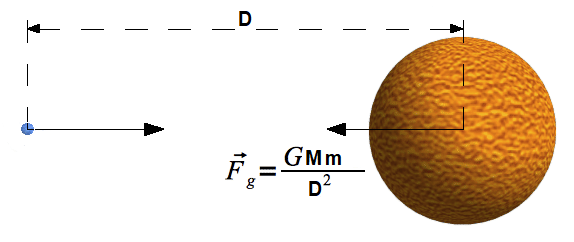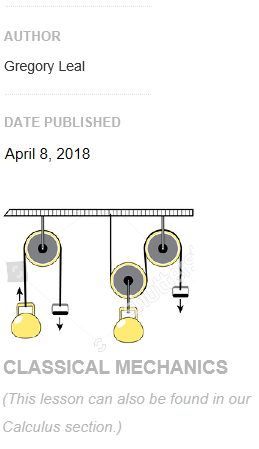Overview
To find the gravitational force exerted by a sphere
of mass \(M\) on a particle of mass \(m\), we must first subdivide that sphere into many very skinny shells and find the gravitational force exerted by anyone of those shells on \(m\). We'll see, however, that finding the gravitational force exerted by such a shell is in of itself a somewhat tedious exercise. In the end, we'll see that the gravitational force exerted by a sphere of mass \(M\) on a particle of mass \(m\) outside of the sphere (where \(D\) is the center-to-center separation distance between the sphere and particle) is completely identical to the gravitational force exerted by a particle of mass \(M\) on the mass \(m\) such that \(D\) is their separation distance.
Finding Gravitational Force Exerted by Shell and Sphere
In this lesson, we'll use Newton's law of gravity and the concept of a definite integral to calculate the gravitational force exerted by a solid sphere of uniform mass density \(ρ\) on a particle of mass \(m\) at the point \(P\) (see Figure 1) where the particle is outside of the sphere. To solve this problem, we must subdivide the sphere into many very thin shells. By finding the gravitational pull exerted on \(m\) by any one of these shells, we can find the total gravitational force exerted on \(m\) by the entire sphere. Finding the gravitational force on \(m\) due to a spherical shell is, in of itself, a fairly tedious problem. To find the force on \(m\) due to a spherical shell, we must subdivide the shell into many very thing rings. Summing the contributions to the total gravitational tug on \(m\) by every ring will give the total gravitational force exerted on \(m\) by the entire shell.
Figure 1: A shell can be subdivided into many very skinny rings. Anyone of these rings can be represented by the ring \(QRR_1Q_1\) illustrated above. Image credit\(^{[1]}\).
In Figure 1, the solid \(QRR_1Q_1\) is one of these rings. We can subdivide this ring into many tiny pieces of volume \(dV\). Since the mass density throughout the sphere is constant, this mass density is given by the equation
$$ρ=\frac{\text{Mass inside of volume}}{Volume}.$$
Using this equation, we can determine that the mass of one of the tiny pieces comprising the ring is given by
$$dm=ρdV.$$
Since each dimension of \(dV\) is infinitesimally small, we can regard the entire mass \(dm\) as being concentrated into a single point. This is good news. Newton's law of gravity only applies to particles and since both the mass element \(dm\) in the ring and the mass \(m\) at \(P\) are particles, we can use Newton's law of gravity to find the gravitational force by \(dm\) on \(m\). Doing so, we have
$$f=Gm\frac{ρ}{QP^2}dV.\tag{1}$$
Equation (1) represents the gravitational force exerted by any mass element \(dm\) in the ring on the mass \(m\) at \(P\). To find the total gravitational force exerted on \(m\) by the entire disk, we must add up all the forces acting on \(m\) due to every mass element \(dm\) comprising the ring. Since very mass \(dm\) is an equal distance \(r\) away from \(m\), each mass \(dm\) exerts an equal force on \(m\). Furthermore, since the \(x\)-component of force exerted by \(dm\) is given by
$$f_x=fsin(OPQ),$$
and since the angle \(OPQ\) is the same for every mass element in the ring, it follows that every mass \(dm\) exerts the same \(x\)-component of force, \(f_x\), on \(m\). When we add up the forces acting on \(m\) due to each mass element \(dm\), for any mass element \(Q_1Q\) on the ring which exerts a horizontal force \(\vec{f}_x\) on \(m\) there is another mass element \(R_1R\) on the ring which exerts \(-\vec{f}_x\) on \(m\). Thus, we only need to add up the \(y\)-components of force (which we'll by represent by \(f_y\)) which are given by
$$f_y=Gm\frac{ρ}{QP^2}dVcos(OPQ).\tag{2}$$
If we add up each force \(f\) exerted on \(m\) by each \(dm\), all of the \(x\)-components of \(f\) cancel leaving us with just the infinite sum of \(f_y\):
$$f_{ring}=\int{f_y}=\frac{Gmρcos(OPQ)}{(QP)^2}\int{dV}.\tag{3}$$
Notice that since every term in Equation (2) is constant for every \(dm\), we were able to pull all of those terms outside of the integral as we did in Equation (3). The integral, \(\int{dV}\), is just the volume of the ring. Thus, Equation (3) becomes
$$f_{ring}=\frac{Gmρcos(OPQ)}{(QP)^2}\biggl(\text{Volume of ring}\biggr).\tag{4}$$
The volume of the ring is given by the product of the rings circumference \(2π(QS)\) and the arc length \(Q_1Q\). Thus,
$$\text{Volume of ring}=2π(QS)(Q_1Q).$$
Using the relationships \(Q_1Q=adθ\) and \(QS=asinθ\), the above equation becomes
$$\text{Volume of ring}=2π(asinθ)(adθ).\tag{5}$$
Substituting Equation (5) into (4), we have
$$f_{ring}=\frac{Gmρcos(OPQ)}{(QP)^2}·2π(asinθ)(adθ).\tag{6}$$
You might be asking why we substituted Equation (5) into (4). As I mentioned earlier, to find the total force exerted by the shell on \(m\), we must add up all the forces due to every ring. In other words, we have to be able to calculate the integral, \(\int{f_{ring}}\). To be able to calculate this integral, we must do something similar to what we have been doing in so many previous lessons concerning the applications of definite integrals; namely, we want to represent \(\int{f_{ring}}\) in the same form as \(\int_a^bf(x)dx\). To do this, we need to represent everything in Equation (6) in terms of a single variable. It is all too easy to get lost in the math and lose track of what we're doing; but everything we have done since deriving Equation (4) and everything that we'll continue to do until we finally take the integral of \(f_{ring}\) will involve altering Equation (4) until it is represented in terms of a single variable.
That tangent aside, let's see if there is anything that we can do to Equation (6) to come closer to reaching our goal. As you can see from Figure 1,
$$cos(OPQ)=\frac{SP}{r}=\frac{D-OS}{r}=\frac{D-acosθ}{r}.$$
Substituting this result in Equation (6), we have
$$f_{ring}=\frac{Gmρ}{r^2}\biggl(\frac{D-acosθ}{r}\biggr)(2πa^2sinθdθ).\tag{7}$$
To make Equation (7) of the same form as \(f(x)dx\), we can either express everything in Equation (7) in terms of \(θ\) or everything terms of \(r\). Doing either would work and would allow us to calculate the integral \(\int{f_{ring}}\). Let's represent everything in Equation (7) in terms of \(r\). We can do this by making the appropriate substitutions to eliminate all of the \(θ\) terms. Let's apply the law of cosines to the triangle \(OQP\) in Figure 1 to get
$$r^2=a^2+D^2-2aDcosθ.\tag{8}$$
Let's take the derivative on both sides of Equation (8) with respect to \(θ\) to get
$$2r\biggl(\frac{dr}{dθ}\biggr)=2aDsinθ.\tag{9}$$
Making some algebraic simplifications, Equation (9) becomes
$$\frac{rdr}{D}=asinθdθ.\tag{10}$$
Also, doing some algebraic manipulations on Equation (8), we have
$$r^2-a^2+D^2=2D^2-2aDcosθ.$$
This equation can be further simplified to
$$r^2-a^2+D^2=2D(D-cosθ)$$
or
$$\frac{r^2-a^2+D^2}{2D}=D-acosθ.\tag{11}$$
It is perfectly natural at this point to be asking yourself we went through the trouble of doing all that. Well, the reason why is because we can substitute Equations (10) and (11) into Equation (7) to eliminate all of the \(θ\) terms and to represent everything in Equation (7) in terms of \(r\). Making these substitutions, Equation (7) becomes
$$f_{ring}=\frac{Gmρ}{r^2}\frac{\biggl(\frac{r^2-a^2+D^2}{2D}\biggr)}{r}(2πa)\frac{rdr}{D}$$
or
$$f_{ring}=\frac{Gmρπa}{D^2}\biggl(\frac{r^2+D^2-a^2}{r^2}\biggr)dr.\tag{12}$$
All of the messy math that we did in the steps in between Equations (4) and (12) was to represent \(f_{ring}\) of the same form as \(f(x)dx\). After all of the messy math we went through, as you can see Equation (12) is of the form \(f(r)dr\). We could've taken the integral, \(\int{f_{ring}}\), a long time ago to get the gravitational force xerted by the entire disk; but not until now (after having had derived Equation (12)) could we write down
$$f_{disk}=\int{f_{ring}}=\int_{?_1}^{?_2}f(r)dr$$
and actually calculate this force. Taking the integral on both sides of Equation (12), we have
$$f_{disk}=\frac{Gmρπa}{D^2}\int_{?_1}^{?_2}\frac{r^2+D^2-a^2}{r^2}dr.\tag{13}$$
As you can see from Figure 1, the lower and upper-limits of integration for the integral in Equation (13) are \(D-a\) and \(D+a\), respectively. Thus,
$$f_{disk}=\frac{Gmρπa}{D^2}\int_{D-a}^{D+a}1+\frac{D^2-a^2}{r^2}dr.\tag{14}$$
To try to attempt to keep things from getting too messy, let's ignore the \(Gmρπa/D^2\) term in Equation (14) for just a moment and let's just focus on calculating the definite integral in Equation (14). Doing so, we have
$$\int_{D-a}^{D+a}1+\frac{D^2-a^2}{r^2}dr=\int_{D-a}^{D+a}(1)dr+\int_{D-a}^{D+a}\frac{D^2-a^2}{r^2}dr$$
$$=\biggl[r\biggr]_{D-a}^{D+a}+\biggl[\frac{-1}{r}\biggr]_{D-a}^{D+a}(D^2-a^2)$$
$$=D+a-(D-a)+\biggl(\frac{1}{D-a}-\frac{1}{D+a}\biggr)(D^2-a^2).$$
If we multiply the two terms, \(1/(D-a)\) and \(-1/(D+a)\), by \((D+a)/(D+a)\) and \((D-a)\(D-a)\), respectively, we have
$$D+a-(D-a)+\biggl(\frac{D+a}{(D-a)(D+a)}-\frac{D-a}{(D+a)(D-a)}\biggr)=2a+\biggl(\frac{2a}{D^2-a^2}\biggr)(D^2-a^2)=4a.$$
Substituting this result for the integral in Equation (14), we have
$$f_{shell}=Gmρπa/D^2(4πa^2).\tag{15}$$
The gravitational force exerted by a shell on a mass \(m\) outside of the shell is given by Equation (15). Since \(ρ\) Is the mass density of the cylinder and \((4πa^2)t\) is its volume, we see that Equation (15) can also be written as
$$f_{disk}=G\frac{mM_{shell}}{D^2}.\tag{15}$$
What Equation (15) means is that a thin shell exerts a force on a aprticle outside of the shell as if all of the shell's mass were concentrated at a single point at the center of the shell. to find the gravitational force excerted by a solid sphere on a particle outside of the sphere, we must add up the forces on \(m\) due to infinitely many, infinitesimally thin shells. Since any such shell is infinitesimally thin, let's replace \(t\) with \(dr\). Taking the integral of both sides of Equation (15), we have
$$f_{\text{Solid sphere}}=\frac{4πGmρ}{D^2}\int_0^Rr^2dr\tag{16}$$
where \(R\) is the radius of the sphere. Calculating the integral in Equation (16), Equation (16) simplifies to
$$f_{\text{Solid sphere}}=\frac{4πGmρ}{D^2}\biggl(\frac{R^3}{3}\biggr)$$
or
$$f_{\text{Solid sphere}}=G\frac{m\biggl(ρ\frac{4}{3}πR^3\biggr)}{D^2}.\tag{17}$$
Since \(ρ\frac{4}{3}πR^3\) is just the mass of the solid sphere, Equation (17) simplifies to
$$f_{\text{Solid sphere}}=G\frac{mM_{sphere}}{D^2}.\tag{18}$$
Equation (18) tells us that a sphere of mass \(M\) and radius \(D\) exerting a gravitational force on a point-mass \(m\) outside of the sphere exerts the same force as a particle of mass \(M\) acting on the point-mass \(m\) such that those two particles separation distance are given by \(D\). When the Earth exerts a gravitational force on an object, if that object is very small compared to the Earth then that object can be approximated as a point-mass and the Earth can be approximated as a sphere with uniform mass density. The gravitational force exerted on such objects is given by Equation (18).
This article is licensed under a CC BY-NC-SA 4.0 license.
References
1. Kline, Morris. "Some Physical Applications of the Definite Integral." Calculus: An Intuitive and Physical Approach. Mineola, NY: Dover Publications, 1998. 502. Print








![Figure 1: A shell can be subdivided into many very skinny rings. Anyone of these rings can be represented by the ring \(QRR_1Q_1\) illustrated above. Image credit\(^{[1]}\).](https://images.squarespace-cdn.com/content/v1/58757ed7f5e231cc32494a1b/1523204844809-FD0IMPJCMHHUYO6LRD2Q/sphere+force.png)